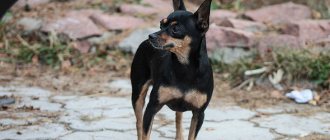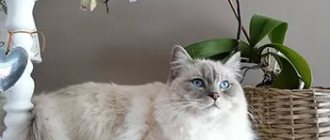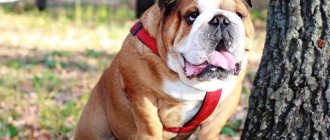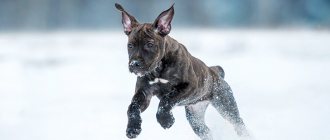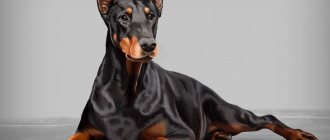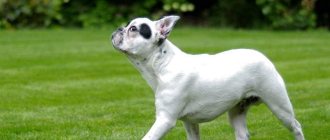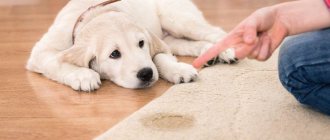Things to consider
First of all, you need to decide on your needs and capabilities. Then choose a suitable breed, and only then look for a good breeder.
We wrote about which dog is better to have in an apartment for a child (without a cat) here >>>
What else is important to consider besides the breed and future material costs? Evaluate your own time: you will need it not only for care and walking, but also for training and communicating with your pet. Otherwise, problems will arise with his behavior.
We take into account the age and character of the children, and our lifestyle. This also includes special life situations and family life.
A dog requires more communication time than a cat. But a dog is a more predictable animal, and it’s easier to build relationships with him.
Basset Hound
Like any cat, the basset loves the comfort of home. But this is not a cat, but a dog, especially a hound. For some reason, dogs of this breed are considered lazy - probably the appearance of the animal is misleading. But basset dogs are very affectionate and loyal, they love communication. They are full of energy, and all this, coupled with sad eyes on an overly important face, makes even the most stern and serious person smile.
However, the reputation of a lazy dog needs to be justified, so Bassets... are simply too lazy to walk, much less run after cats. But - “Cats are not a hindrance to happiness!”
Small or large
Different dogs are adapted to living in an apartment with children and a cat: small, medium and even large. Their needs for care, companionship, walks, physical and mental exercise depend not only on size, but also on breed.
Sometimes it seems that keeping a small dog is easier. But it is not always the case. Sometimes kids are much louder and more active at home than larger, calm dogs who splash out their energy on the street.
Even small dogs need walking, playing with their relatives, training and communication with their owners. Otherwise, pets develop behavioral problems: aggression, barking, damaging things.
Not all miniature breeds are so suitable for families with small children. So, Chihuahuas, Russian toy terriers, Yorkshire terriers are very capricious dogs and do not always favor children. Plus, a child can easily injure a fragile animal.
Another popular dog, the Jack Russell Terrier, is also not very suitable. A representative of this hunting breed is very active, sometimes shows aggression towards children, chases cats, and therefore requires a firm hand and patience when raising.
Chihuahua
The Chihuahua is a very confident dog. She also has plenty of courage. You can often see how this small dog bullies huge dogs. The average weight ranges from 2.5 to 3 kilograms. She has thin legs and a funny face. But, despite their complex nature, representatives of this breed get along well with cats. In the company of a Chihuahua, the cat will feel calm. She will understand that her safety is not in danger. She simply will not perceive the dog as a serious opponent. A very important condition is proper acquaintance. It is better if the animals are young. An adult cat is unlikely to like the fact that his quiet life is disturbed by an incomprehensible animal. If they become friends, the fun will never leave the owners' house. They will play, sleep together, even eat from the same bowl.
Suitable Dog Breeds
For a family with children and a cat, a good-natured, sociable, manageable dog with a balanced psyche is suitable. The remaining qualities - activity, level of intelligence, protective qualities, playfulness, noisiness, appearance - lie in the area of personal preferences.
Let's briefly look at the TOP 12 breeds that have all the qualities to get along in an apartment with children and a cat. These dogs are also classified as family breeds.
Maltese (Maltese dog)
A charming decorative companion dog that delights owners with its friendliness, sensitivity, playfulness and obedience.
Weight 2.5-4 kg. Height (at the withers) 20–25 cm. Life expectancy 12–14 years.
He has an excellent balanced character. He is friends with adults, children and cats. Great for a city apartment.
Loves to communicate, play, and sometimes bark loudly. Subtly senses the mood of the owners. If everyone is busy, she can occupy herself for a while.
Maltese dogs have virtually no odor, especially girls. Wool is considered low allergenic. But a beautiful fur coat requires care: combing, cutting, washing. But it hardly sheds.
Before bathing, the fur should be wetted and combed so that it does not mat during washing.
The pet needs daily walks. The breed is inquisitive and sociable.
The lapdog should be taught basic commands and not allowed to dominate its owners. If a pet considers itself to be in charge, it will become disobedient. Plus he will worry and whine when everyone leaves the house.
To avoid food allergies, you need to adhere to proper feeding. The diet should not contain sweets, flour, or smoked foods.
Bichon Frize (French lapdog)
A small decorative dog with white fluffy fur. Affectionate, playful, gets along with all family members and even the cat. Doesn't need long walks.
Weight 3-6 kg. Height (height at withers) 25-30 cm. Life expectancy 12-15 years.
Bichons fit perfectly into city apartments. Almost no shedding and no smell.
Dogs are artistic and love attention and affection. In order for the pet’s character to please its owners, it must be educated and taught basic commands. Bichons train well with praise and treats.
Careful skin and coat care is required. Plus the selection of food, as there are food allergies. Its presence is noticeable by its watery eyes. In winter, in cold weather, you need clothing for walking.
Pug
A wonderful companion for adults and children living in a city apartment. Pugs are friendly to people, other dogs, and cats. They do not need long walks. Suitable for beginner dog owners.
Weight 6–8 kg. Height (height at withers) 28–32 cm. Life expectancy 13–14 years.
Dogs are not capricious. They are very attached to their owners, so they do not like to be alone for a long time. They get along well with children and cats.
Puppies love to play. Adult dogs are less active and tend to behave calmly. They love leisurely walks and are happy to lie down next to their owners. Pugs rarely bark, and especially in vain.
The pug doesn’t particularly like to learn commands and is sometimes stubborn. However, treats are a magical remedy that will inspire a lazy student to exploits.
Needs daily walking. Walking in good weather is allowed for up to 1.5 hours. Jogging should not exceed 10–15 minutes: the respiratory system of this breed is not designed for heavy loads.
Please note: hypothermia and overheating are very dangerous for a pug. Not only on the street, but also at home.
Grooming includes cleaning wrinkles on the face and combing out the fur during shedding. Also, a pug should not be overfed: the breed is prone to obesity.
Poodle
A beautiful, smart, artistic, obedient dog. A devoted friend who gets along with adults, children and cats. There are large, small, dwarf and toy poodles.
Weight and height (height at withers): large 20–30 kg and 45–60 cm; small 8–14 kg and 35–45 cm; dwarf 6–8 kg and 28–35 cm; that one is about 2.5 kg and 24–28 cm. Life expectancy is 12–15 years.
The dogs are very sociable. They can easily read the mood of family members. It is important for them to communicate with everyone. Without attention, love and affection, they become depressed.
The poodle varieties are similar in character. Except that toys are less energetic and can be shy. Cowardice is smoothed out by proper education.
Poodles are easy to train and remember commands. They can be taught to put toys away in their box, fetch things, and perform various tricks. The main thing is that training methods rely on praise and treats. You cannot shout or punish them rudely: poodles have a vulnerable psyche.
For all its friendliness, the poodle can try to dominate its owners. This cannot be allowed: calmly but persistently you need to show the dog his lower place in the family hierarchy.
Dog fur is considered low allergenic. Pets hardly shed. But the fur coat requires regular care: combing, removing tangles, cutting. There are many options for model “hairstyles”, so there is plenty to choose from.
An active breed that needs daily walks, ball games, and jogging. But even in front of the TV, the pet will happily keep company with its owners.
Chinese Crested Dog
Decorative indoor dog: affectionate, loyal, friendly and playful. Chinese Cresteds are hairless and downy, and vary in build and color.
Weight 3–5 kg. Height (height at withers) 23–33 cm. Life expectancy 12–14 years.
The dog needs close contact with its owners. She does not like to stay at home alone for a long time: she may begin to feel sad and howl.
Friendly towards children and other animals, including cats. Sometimes the dog itself needs protection from both, which must be provided.
The breed is emotional and can bark. This is partially smoothed out by upbringing, but the pet will not become completely silent.
Pesky will be happy to play and frolic, learn commands and even show numbers. You just can’t shout at him: his psyche is fragile.
Almost no smell. The downy representatives of the breed hardly shed. Hairless and downy varieties require special and careful skin and coat care.
Hairless dogs need to be protected from sunburn in hot weather and from hypothermia in cold weather. Plus, they are not suitable for trips into nature: insects, sun, branches can damage the skin.
Spaniels
English and American Cocker Spaniels and Russian Hunting Spaniels are beautiful, kind, sociable dogs, excellent friends for all family members and cats.
Weight 7–16 kg. Height (height at withers) approx. 40 cm. Life expectancy 12–14 years.
The breeds are similar in appearance, but also have noticeable differences. Above is a picture of an English spaniel, and in the photo below is an American one. The latter has a shorter muzzle and longer, silky fur.
And here is a photo of the handsome Russian. The colors of each of these 3 varieties of spaniel are different.
Dogs are positive, very playful, sometimes until old age. They love to run and play with a ball and a stick. They need sufficient walking, physical activity, and interaction with other dogs.
The breed requires close contact with its owners, communication, and attention. These pets do not like to be left alone for a long time. Despite their hunting instincts, dogs get along peacefully with cats.
Spaniels are well trained, especially Russians. Education is necessary to prevent your pet from sitting on its head. However, obedience must be achieved without harsh methods.
The British and especially the Americans need careful coat care. Plus, all spaniels need to take care of their ears: they need to be cleaned inside.
To prevent the dog's ears from getting dirty when feeding him food, they should be carefully lifted up and gently fixed. Or you should choose tall and stable containers for food and water, where the muzzle can climb, but the ears will not fall.
You should not overfeed your pet, as spaniels are prone to obesity. This is especially true for Russians: do not be fooled by his plaintive views, rely on healthy eating standards.
Welsh Corgi (Pembroke and Cardigan)
Charming herding dogs are great for families with children and a cat. Small shepherd dogs have a peaceful, balanced character. They are very attached to their owners and give them a lot of positive emotions.
Welsh Corgi Pembroke:
Weight 9–13 kg. Height (height at withers) 25–30 cm. Life expectancy 9–12 years.
Dogs of this breed are very patient with the affection of children. But you should explain to children that a dog is not a toy. Moreover, all corgis need to take care of their back: this is the weak point of the breed. A long spine with short legs experiences a lot of stress. Jumping from heights is contraindicated for dogs. But you can have fun running.
Welsh Corgi Cardigan:
Weight 12–17 kg. Height (height at withers) 25–30 cm. Life expectancy 12–15 years.
Welsh Corgis are very smart dogs. At the same time, they should be raised consistently: you need to immediately decide what to allow them and what not.
The care is normal. It is necessary to provide physical activity in the fresh air, provide toys, not overfeed, and pay enough attention.
Labrador Retriever
A popular breed of family dogs that has gained fame as an excellent nanny for small children. Labradors are intelligent, loyal, obedient medium-sized dogs. Adapted to living in a city apartment, subject to regular physical activity on the street.
Weight 25–34 kg. Height (height at withers) 53–61 cm. Life expectancy 12–13 years.
Labs are well trained. Strong, active dogs enjoy playing with a ball and sticks, running and frolicking. They are patient with children's affections and get along with cats. After all, their character is extremely peaceful.
The care is normal. Requires physical activity in the fresh air. Do not overfeed: Labradors are prone to obesity.
If you have no experience keeping large dogs, you should seek help from a dog handler. Take at least a few lessons or a full course. This is necessary for the proper education of the dog.
Golden Retriever (Golden Retriever)
Very similar to a Labrador. A wonderful companion with a peaceful character. The breed is great for families with children. He gets along well in a city apartment provided he gets enough exercise. Externally, a Golden can be distinguished from a Labrador by its longer coat.
Weight 25–41 kg. Height (height at withers) 51–61. Life expectancy is 12–13 years.
Goldens are smart. But they need education. They are trained well.
A very sociable breed. Needs communication with owners, attention and affection. Patient, balanced dogs who do not like to bark in vain. They get along with children and cats with proper guidance from their owners. Have a beneficial effect on the psyche of children.
Do not allow children to sit on top of the dog: this can damage the spine or cause a arch in the back.
Beautiful fur requires care. The main problem is shedding. Combing will help reduce the amount of cleaning. In addition, goldens should not be overfed due to their tendency to become obese.
Bernese Mountain Dog (Bernese Shepherd)
An affectionate dog with a very impressive appearance, a kind of peace-loving good-natured person. A great friend for the whole family.
Weight 36–50 kg. Height (height at withers) 58–70 cm. Life expectancy 8–10 years.
Despite its large size, the Mountain Dog lives well in apartment conditions. The main thing is to provide the dog with sufficient physical activity in the fresh air.
The dog has a very calm character. He is friends with everyone: adults, children, other animals, even cats. This makes him a great family dog.
Mountain Dogs are highly trainable. True, they can sometimes show stubbornness, which must be overcome in order to raise an obedient and controllable dog.
From the very beginning, stop the puppy’s attempts to jump on you good-naturedly. After all, when he grows up, a 50 kg dog will fall on you, and this is no longer so touching.
The coat is very beautiful, but sheds, which will require regular care and house cleaning.
You can place your dog on the glazed balcony. You will need a kennel to keep your pet from freezing in the cold. Plus, you need to make sure that in the summer heat the dog’s place does not overheat.
Collie (Scottish Sheepdog)
Large shepherd dog, beautiful, kind, emotional. The collie's peaceful nature allows it to get along well with people and other animals.
Since the late 90s there have been two varieties: longhair and shorthair.
Weight 19–34 kg. Height (height at withers) 51–61 cm. Life expectancy 12–13 years.
The dog is playful and active. But there is no need to be afraid of disorder in the apartment: provided long and active walks outside, the collie behaves calmly at home.
The breed is not for lovers of silence. The dog is very talkative, loves to communicate with his voice and sometimes loudly.
Collie is very peaceful. The pet will not become a guard. But the dog, who grew up and raised with children and cats, communicates very well with them.
The puppy must be taught basic commands from childhood. Collies are intelligent and very trainable. But only in a friendly atmosphere.
It should be taken into account that the collie’s psyche is vulnerable. In a family where people communicate in raised voices, the dog will become nervous and incomprehensible due to stress.
Luxurious wool requires care all year round. It requires frequent brushing. But you should wash it only 2-3 times a year. You also need to pay special attention to eye hygiene.
What should you do if you really like a collie, but it’s scary to have such a big dog in your apartment? Pay attention to the Sheltie. This is almost a copy of a collie, only almost 2 times smaller in size.
Sheltie (Shetland Sheepdog)
A herding breed that today is an excellent companion for city dwellers. Energetic, beautiful dogs, affectionate and kind friends for the whole family.
Weight 5–11 kg. Height (height at withers) 33–39.5 cm. Life expectancy 12–14 years.
The Sheltie has a peaceful disposition. Treats children well. Gets along easily with other animals and cats. At the same time, it has excellent watchdog qualities.
She is sociable, so she doesn’t like to sit alone for a long time. The dog is delicate, sensitive, and perfectly understands the mood of its owners. He chooses his favorite from the family, but at the same time communicates well with everyone.
Loves to play, run, bark. Needs walking and playing outdoors.
The breed is very smart and well trained. Successfully masters agility and can become a participant in a dog show. But the psyche is delicate and requires delicate handling.
The fur will have to be brushed regularly. Ear and eye hygiene will require attention.
Undesirable pet compatibility
There are several unwanted unions where even the compatibility of animals according to the horoscope will not help:
Rabbits and dogs. Dogs perceive eared animals as toys, which is not to their liking. Hearing growls and barks, the rabbit can attack the dog, bite and begin to run around the house in fear, destroying everything in its path.
The combination of hunting and fighting dogs is especially dangerous, as sooner or later they will tear apart the furry animal.
- Turtles and dogs. Such a union is acceptable if the turtle was the first in the apartment: the new tenant will not bother her. But, if the dog was already in the crowbar, and you bring a turtle, expect problems. The dog will play with her and unwittingly injure her not very hard shell. In this case, it is better to take a small lap dog.
- Birds and cats. Parrots, canaries, owls and other birds are not friends to cats. Cats will try to catch the bird and will keep it in fear all the time, and severe stress is destructive for birds, sometimes leading to death.
Judge for yourself: rarely does a cat not see a bird as prey, and prey must be caught and eaten.
Cats and rodents. Guinea pigs, rats, hamsters and even more so mice are another potential prey for tailed and baleen animals. If you do decide to get a rodent, keep the cage where the cat cannot reach it, and add additional protection in the form of a mesh.
And don’t let rodents wander around the house where the cat lives: even if you lock him in another room, no one guarantees that he won’t get out of there.
Difficult rocks
Aboriginal dog breeds are considered difficult to train and live in an apartment with children and a cat. They require a special approach and training. Otherwise, pets can be dangerous for children and even adults.
What breeds are considered native? Let's list the popular ones:
- likes;
- husky;
- Ridgebacks;
- Spitz;
- Akita Inu;
- Shiba Inu;
- Basenji.
These dogs have an independent character and tend to make independent decisions. You need to understand the characteristics of these breeds very well in order to raise a manageable pet. It is not recommended for beginners who have no experience with dogs to get them.
Bichon Frize
Bichon Frize are companion dogs. They are gentle and playful, cheerful. Ideally combined in size with representatives of the cat family. Their weight reaches 5.5 kilograms. They get along well with other pets, not just cats. The Bichon will respond well to having a second animal in the house. They simply cannot stand being alone. But the owner will also have to work a little, otherwise the dog will not obey. Bichon Frize are smart and cunning.
How to reconcile a cat and a dog
The easiest situation is when the kitten and puppy grow up together. Then, with the right guidance from the owners, pets can become good friends.
But the dog can also get along with an adult cat. Unnecessary conflicts between animals can be avoided if each animal is allocated its own territory.
The cat should have an elevated place where he can retreat from the annoying pestering of a puppy or in the event of a conflict with an adult dog. There the cat will be able to retire in time, relax and, perhaps, even have a snack. This is especially important when the owners are not at home.
As you can see, if you want to have a dog in an apartment with children and a cat, then this is quite possible. Which breed is better? One of the family ones from our list will do. This is the safest and easiest option.
But! Without proper training, any dog can harm a child. It is not only the breed that is important here, but the opportunity to devote time and effort to raising a dog. With the proper approach and attention, dogs of many breeds have a chance to become a good friend for children, adults and even cats.
Shih Tzu
Dogs of this breed have a calm character, but they are too self-sufficient. In principle, their name justifies it. Shih Tzu means "lion cub" in Chinese. To make him friends with a cat, you will have to be a little nervous. The dog is very capricious and considers itself the most important person in the house. The cat thinks exactly the same. Relationships can only be improved if the dog receives a decent upbringing. If you don’t take care of her, she will soon not even take into account the owner’s opinion. The dog has a light weight of 4 to 7 kilograms. When introducing animals you need to be very careful. The best option for animals would be separate rooms. Let them play and communicate under the supervision of their owners, at least for the first time.
Comments
- Top
- All comments
“Network publication “Woman’sDay.ru (Woman’sDey.ru)” Certificate of registration of mass media EL No. FS77-67790, issued by the Federal Service for Supervision of Communications, Information Technologies and Mass Communications (Roskomnadzor) December 13, 2016 16+.
Founder: limited liability company "Hirst Shkulev Publishing"
Editor-in-Chief: Dudina Victoria Zhorzhevna
Copyright (c) Hirst Shkulev Publishing LLC, 2022.
Any reproduction of site materials without the permission of the editors is prohibited.
Contact information for government agencies (including Roskomnadzor):
Introduce animals to each other correctly
Often the first meeting is the decisive factor in the relationship between four-legged neighbors, at least in the coming weeks. And according to some behaviorists, it is even the key to success in terms of their relationships.
During the first steps of a newcomer in the house, you need to ensure that the new resident is introduced to the new environment, and the already settled pet is not harmed. A domesticated four-legged animal feels like the master of the situation, because it is he who is at home and every newcomer will initially be perceived as an intruder. Therefore, one can expect a “fie” from him.
Take care of the comfort of the “old” tenant without fundamentally disturbing his space or rituals. Let the food bowl and bed remain in place. The new tenant must adapt to the existing situation. This will be much easier for him than changing habits in the case of a domesticated animal.
First steps:
- Allow the newcomer to get acquainted with the new home, but do not allow the second four-legged to violate the zone.
- At first, place the animals in separate rooms so that they feel their own and others' presence and get used to it.
- The next step is to familiarize the animals with their smell. The best way to do this is by placing an object in the den that carries the neighbor’s scent, for example, by changing the bedding.
- Control the initial contact and prevent possible aggression or conflict, for example by putting the dog on a leash and allowing the cat to decide how far it wants to approach. You can unhook the leash only when a calm atmosphere reigns between the four-legged animals.
- The first contact should be short enough so that the animals can part in a phase of mutual interest, and the atmosphere between them remains friendly.
- It is also important to monitor the pets' interactions in the coming days.
- At night, each pet should sleep in its own den.
- Do not allow four-legged animals to be deprived of contact for long periods of time. They must communicate daily.
If you have already managed to effectively overcome the first step, i.e. To get to know each other as a dog and a cat and establish a thread of understanding, we can say that you have already done half the work. However, the main work is still ahead!
What mistakes should you avoid to support healthy pet relationships?
